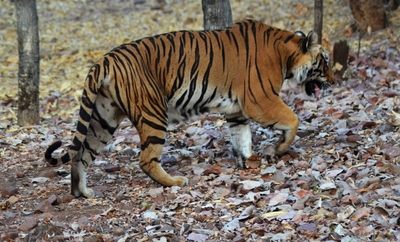
CENTRAL INDIAN HIGHLANDS WILDLIFE FILM FESTIVAL 2014
Theme: Landscape Dynamics & Biodiversity

CENTRAL INDIAN HIGHLANDS WILDLIFE FILM FESTIVAL 2014
Theme: Landscape Dynamics & Biodiversity







JUNGLE CAMPS 2014
SATPURA TIGER RESERVE (Madhya Pradesh)
Nestled in the mighty mountain ranges of Satpura, the lush green virgin jungles of the Satpura Tiger Reserve form a major part of the ‘largest contiguous tiger habitat’ in the entire world. Established in 1981, the reserve boasts of a wide variety of flora and fauna along with a unique ecosystem. The Indian Giant squirrel, wild dog, marsh crocodile and gaur ( largest animal of cow family ) are special attractions along with tiger, leopard, sloth bear, chital, sambhar and a wide variety of birds and floral-species.
DZUKOU VALLEY (Nagaland)
Dzukou Valley (Nagaland) is a beautiful picturesque protected forest area of Nagaland. The Great Indian Hornbill is one of the most famous birds found in the state. Blyth's Tragopan, a vulnerable species of pheasant, is also found in the state and is the State Bird of Nagaland. It is often sighted in Dzükou valley. In fact, of the mere 2500 tragopans sighted in the world, Dzükou valley is the natural habitat of more than 1,000. Mithun (a semi domesticated Gaur) found only in the North Eastern states of India, is the State animal of Nagaland and has been adopted as the official seal of the Government of Nagaland. It is ritually the most valued species in the state.
KAZIRANGA NATIONAL PARK ( Assam)
Known all over the world as the best place to observe the Great Indian one-horned rhinoceros, the Kaziranga National Park also happens to be the protected area with the highest density of tigers in the entire world. The other unique attractions include wild buffalo, elephant, swamp deer, hog deer, golden langur, Hoolock gibbon, Ganges dolphin, reticulated python and King Cobra.
BANDHAVGARH TIGER RESERVE (Madhya Pradesh)
Erstwhile ‘shikargaah’ of the Rajas of Rewa state, Bandhavgarh was declared a national park in 1965. It happens to be the national park with highest tiger density in the entire central India. It is often said that if you have not seen at least 4 tigers at Bandhavgarh, you should regard you have seen none. The park boasts of remains of a fort believed to have been built by Lord Rama for Laxman.The park also has man-made caves, carvings and inscriptions dating back to 2nd century AD, along with some beautiful statues dating back to 10th - 11th century. The ‘Sheshshaiya’ statue carved out of a single big rock is very famous. The park is full of typical central Indian wildlife including tiger, leopard, sloth bear, wolf, fox, wild dog, hyaena, sambhar, chital and wild boars.
PENCH TIGER RESERVE (Madhya Pradesh)
Established in 1992, the Pench Tiger Reserve is famous for its pristine natural beauty. The well-known forest-saga by Rudyard Kipling --‘Jungle Book’ --- is based on the animals and jungles of Pench. The forest also finds prominent mention in the wildlife books of Capt. James Forsyth. Tiger, leopard, wild dog, jackal, gaur, sambhar, chital and wild boar are the main faunal species of the reserve.
The detailed schedule of jungle camps (conservation awareness programmes) is given below. In oreder to participate in one or more camps, please click on the link and fill-up the registration-form.
SCHEDULE OF JUNGLE CAMPS
|
CAMP CODE |
CAMP VENUE |
DATE |
REGISTRATION |
|
CIHWFF14-CAP01 |
SATPURA TIGR RESERVE (MP) |
OCT 16-19, 2013 |
CANCELLED DUE TO MADHYA PRADESH ASSEMBLY ELECTIONS |
|
CIHWFF14-CAP02 |
DZOKOU VALLEY (NAGALAND) & KAZIRANGA NATIONAL PARK (ASSAM) |
NOV 7-13, 2013 |
REGISTRATION CLOSED |
|
CIHWFF14-CAP03 |
SATPURA TIGER RESERVE (MP) |
DEC 11-14, 2013 |
REGISTRATION CLOSED |
|
CIHWFF14-CAP04 |
BANDHAVGARH TIGER RESERVE (MP) |
JAN 9-12, 2014 |
REGISTRATION CLOSED |
|
CIHWFF14-CAP05 |
PENCH TIGER RESERVE (MP) |
JAN 31,FEB 1-3, 2014 |
CLICK HERE TO REGISTER
|
NOTE: TOTAL NUMBER OF PARTICIPANTS IN ONE JUNGLE CAMP IS NOT MORE THAN 13; ADMISSION WILL BE ON FIRST-COME-FIRST-SERVE BASIS.
COPYRIGHT : CREW, 2013
ALL RIGHTS RESERVED. NO MATERIAL FROM THIS WEBSITE MAY BE REPRODUCED IN ANY FORM WITHOUT THE PRIOR PERMISSION OF CREW.